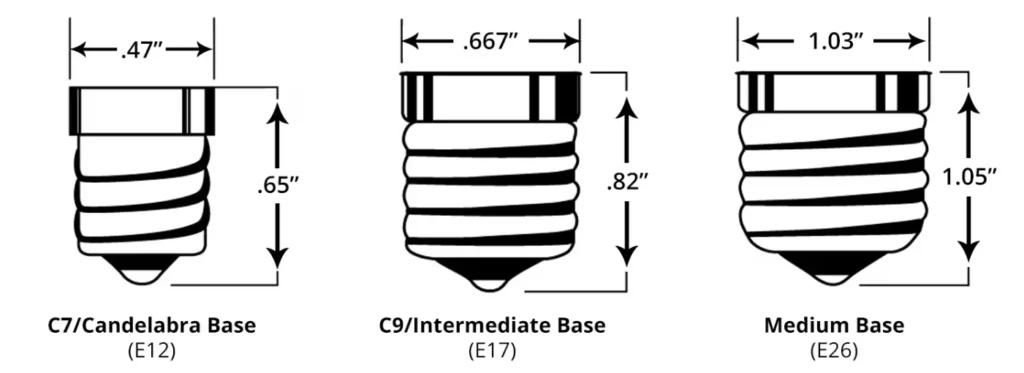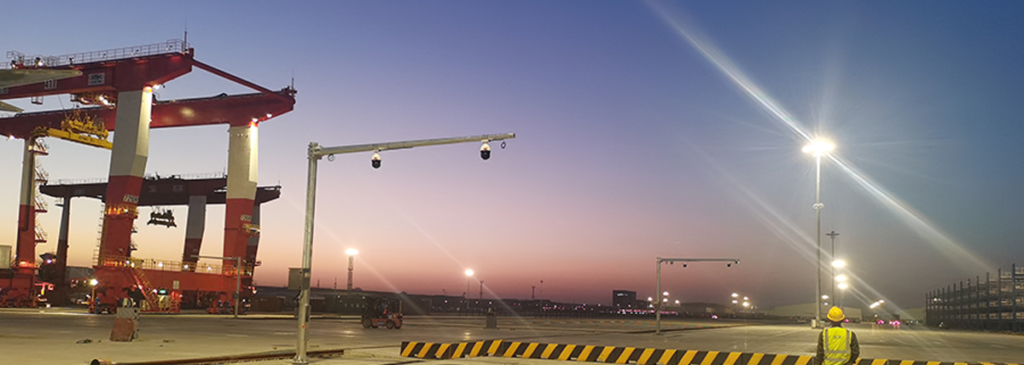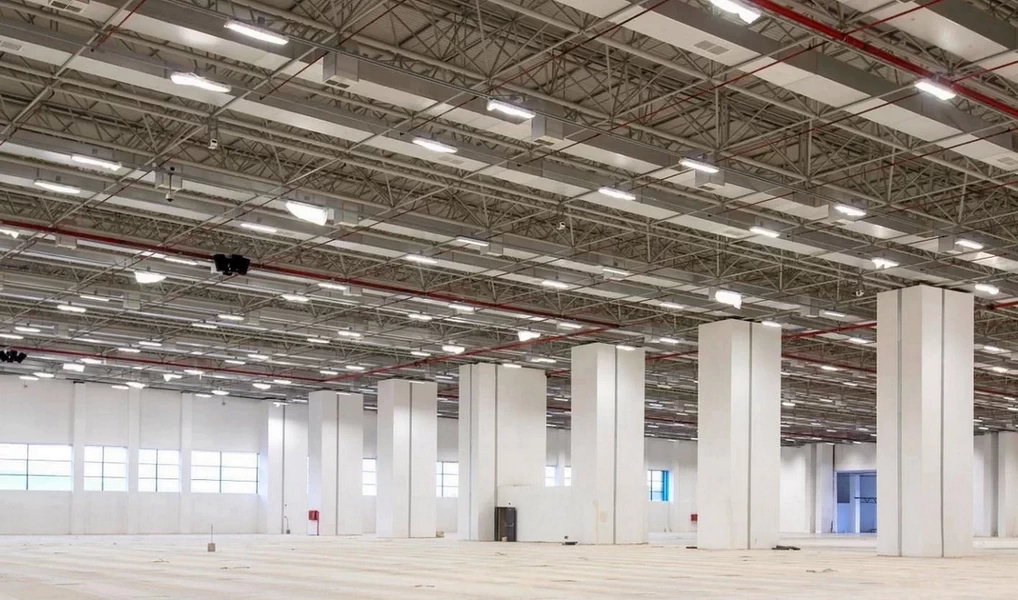Table of Contents
ToggleStandard Bulb Base
For effective illumination, it is essential to choose the appropriate light bulb base types, comprehend bulb base sizes, and recognize the best E12 bulbs. This article explores a variety of light bulbs, such as candelabra light bulbs, e26 base bulbs, and bulbs with prongs, ranging from small bayonet cap alternatives to type A bulbs. Examine contrasts like br30 vs. br40 and A19 vs. A21 light bulbs, and learn about LedRhythm’s cutting-edge lighting products for optimal energy efficiency.

What is a standard light bulb base?


There’s no single, unified global standard, but different regions have their own “mainstream standards.” When purchasing, prioritize local standards.
| Region | Preferred Base Types |
|---|---|
| Mainland China | E27, E14, GU10 |
| United States | E26, E12, GU24 |
| Europe | E27, E14, G9 |
| United Kingdom | B22, E27 |

What are standard light bulb base types and sizes?
| Base Type | Code | Description | Key Dimension | Common Applications |
|---|---|---|---|---|
| Screw | E27 | Standard screw | Outer diameter ≈ 27mm | General household bulbs (living room, bedroom) |
| E14 | Small screw | Outer diameter ≈ 14mm | Decorative lamps, fridge bulbs, crystal lights | |
| E40 | Industrial screw | Outer diameter ≈ 40mm | Streetlights, factory lighting, high-wattage | |
| Bayonet | B22 | Standard bayonet | Base diameter ≈ 22mm | Ceiling lights, traditional home fixtures |
| B15 | Mini bayonet | Base diameter ≈ 15mm | Fridge lamps, night lights | |
| Bi-pin | GU10 | Twist-lock bi-pin | Pin spacing ≈ 10mm | 220V spotlights |
| GU5.3 | Low-voltage bi-pin | Pin spacing ≈ 5.3mm | 12V spotlights (with transformer) | |
| G9 | Loop bi-pin | Pin spacing ≈ 9mm | Chandeliers, wall lamps (LED) | |
| G4 | Micro bi-pin | Pin spacing ≈ 4mm | Cabinet lights, small bulbs (12V) | |
| Fluorescent | G13 | Bi-pin for long tube | Pin spacing ≈ 13mm | T8/T10/T12 fluorescent tubes |
| G5 | Bi-pin for slim tube | Pin spacing ≈ 5mm | T5 fluorescent tubes | |
| Special Type | R7s | Double-ended linear | Lamp tube length(78/118/254mm) | Halogen floodlights (stage, outdoor) |

Standard incandescent bulb base types and sizes
Incandescent lights don’t have their own dedicated bases; they share the same base system as modern LED lights. Bases like E27, B22, and GU10, popular in the incandescent era, are fully compatible with LED lights and remain the mainstream in the market today.
So incandescent base = modern standard base of light bulb, and sizes are the same. Such as E27, B22, E14, E40, GU10, and B15.
Comprehending Small Light Bulbs and E12 Bulbs
What is an E12 bulb?
The candelabra base bulb, also called E12 bulb, has a tiny screw-in base that makes it perfect for ornamental lights, chandeliers, and small light bulbs.
- Meaning of Name
“E”: stands for Edison screw; “12”: thread diameter ≈ 12 mm. Commonly known as: Candelabra screw, small screw (smaller than E14). - Physical Characteristics: Fine threads and a compact design
E12 vs. E14: The thread diameter is 2mm smaller; E12 vs. E26: The thread diameter is only half that of the E26. The lamp base is made of metal, and the insulation is usually ceramic or high-temperature-resistant plastic.

Why Do People Like Small Light Bulbs?
For applications needing small but efficient illumination, small light bulbs, such as type B bulbs and C7 light bulbs, are perfect. Among the examples are:
- C7 LED light bulbs for ornamental string lighting
- E17 light bulbs for intermediate fixtures
- B10 bulbs for chandeliers
Light Bulb Types and Base Sizes
Different light bulb types are available, each of which is appropriate for a certain lighting requirement:
| Light Bulb Type | Base Size | Use Case |
|---|---|---|
| Type A Bulb | E26 base bulb | Standard home lighting |
| Type B Bulb | E12 bulb | Decorative fixtures and chandeliers |
| BR30 Bulb | Medium base E26 | Recessed lighting |
| G25 Bulb | Candelabra base size | Globe fixtures and vanity lights |
| T10 Bulb | E12 socket | Specialty lights and appliances |
E12 vs E26 Comparison Table
| Feature | E12 Base | E26 Base | Compatibility |
|---|---|---|---|
| Common Name | Candelabra Screw | Medium Screw | ❌ Not compatible |
| Thread Diameter | 12 mm | 26 mm | 14 mm difference |
| Typical Application | Decorative lights, crystal lamps, string lights | Main home lighting (living room, bedroom) | Completely different purposes |
| Common Wattage | LED 1–5W (equivalent to 15–40W incandescent) | LED 6–15W (equivalent to 40–100W incandescent) | E12 is lower wattage |
| Rated Voltage | 120V (North America); needs adapter for 220V regions | 120V (North America), 220V (Global versions available) | Different voltage requirements |
| Bulb Shape | Slim (Flame tip F15 / Bullet CA10) | Bulky (Standard A19 / A21 bulb shape) | Significant size difference |
| Typical Installation | Multiple bulbs per fixture (6–24 sockets) | 1–2 bulbs per fixture | Different design logic |
E12 vs B11 Comparison Table
| Feature | E12 Base | B11 Code | Essential Difference |
|---|---|---|---|
| Definition | Base type (screw socket) | Bulb shape (not a base!) | Completely different categories |
| Physical Attribute | Metal screw (12 mm diameter) | Glass bulb diameter ≈ 3.5″ (89 mm) | Unrelated specifications |
| Common Combinations |
– E12 base + B10 flame bulb – E12 base + B11 globe bulb |
B11 bulb can fit E26 / E12 and other bases | B11 refers to bulb shape code |
| Application Example | E12 base + decorative bulbs | e.g., BR30 is a shape, can fit E26 base | Shape and base are independent |
| Common Misunderstanding | Often mistaken as a shape | Correct: B11 indicates bulb width | Easily confused naming |
Comprehending standards light bulb socket
what is a standard light bulb socket size?
A “standard light bulb socket” refers to the connector on a light used to secure and power a light fixture. Its dimensions must strictly match the bulb base. Because there’s no global standard, socket size is determined by the type of base it fits into.
Therefore, standard bulb socket types correspond to bulb base types. For example:
- E Series: Bulb sockets E27, E14, E40, and E12 correspond to bases.
- B Series: Bulb sockets B22, B15, and BA15d correspond to bases.
- G/GU Series: GU10, GU5.3, G9, and G4.

Important Types of Light Bulbs
Type A vs Type B Bulb
- Type A bulbs: Often referred to as A19 light bulbs and A15 bulbs, these bulbs are utilized in ceiling fixtures and table lamps.
- Type B bulbs: Perfect for chandeliers, these slim, torpedo-shaped bulbs resemble B10 bulbs and B11 bulbs.
Key differences: Type A bulbs frequently use E26 sockets, but Type B bulbs have a smaller base similar to E12.
Candelabra Light Bulbs
Candelabra Bulb is a decorative lighting bulb designed for chandeliers, wall lights, and retro lights. It is named because of its candle-like shape.
- Appearance: Elongated, tubular, often with a flame-shaped, pointed, or wavy top, simulating the burning of a candle.
- Candelabra base size: North America: E12 (12mm thread); Europe/China: E14 (14mm thread) or B15 bayonet.
Candelabra base bulbs, like the E12 chandelier bulbs and the C7 light bulbs, are made for smaller, ornamental installations. Among the options are:
- B10 light bulbs and C7 replacement bulbs
- E12 incandescent bulbs
- E12 LED bulbs for energy efficiency
Selecting the Proper Light Bulbs for Particular Uses
Indoor Applications
A19 light bulbs, BR30 bulbs, and R20 bulbs are commonly used for indoor lighting. Certain fixtures might be needed:
- Ceiling fan light bulbs: Typical sizes include E12 base bulbs or A15 bulbs.
- 3-way bulbs: Ideal for table lamps with adjustable lights.
- Appliance bulbs: Small bulbs like T10 light bulbs.
Outdoor Applications
A19 light bulbs, BR30 bulbs, and R20 bulbs are commonly used for indoor lighting. Certain fixtures might be needed:
- Ceiling fan light bulbs: Typical sizes include E12 base bulbs or A15 bulbs.
- 3-way bulbs: Ideal for table lamps with adjustable lights.
- Appliance bulbs: Small bulbs like T10 light bulbs.

Summary: Selecting the Proper Types of Light Bulbs Base
When choosing a bulb type, first look at the bulb interface, and then quickly match the base type according to the region and purpose.
Quick Tips:
- For thick screws, choose E27/E26
- For thin screws, choose E14/E12
- For plug-in lamps, look for G or GU
- For British homes, remember to have B22
People Also Ask
How Do E12 and E26 Bulbs Differ From Each Other?
The E26 base bulb is typical for residential installations, whereas the E12 bulb has a smaller base.
- E12 (small screw): Approximately 12mm in diameter, commonly used in small lamps such as chandeliers, nightlights, and decorative lights.
- E26 (medium screw): Approximately 26mm in diameter, this is the most common standard light socket in North America and is used in household lighting, ceiling lights, table lamps, and other conventional lights.
Simply put, the E12 is much smaller than the E26 and is used for low-wattage decorative lights; the E26 is the standard for household light bulbs in the United States.
Candelabra Base Bulbs: What Are They?
Candelabra bulbs use the E12 base size, which is used for ornamental lighting and chandeliers.
A Type B Light Bulb: What Is It?
- A Type B bulb is a designation for a bulb shape, commonly found in decorative lighting fixtures.
- It’s often paired with an E12 (candelabra base) bulb; it’s used in pendant lights, wall sconces, candelabra, mirror lights, and more.
In short, a Type B bulb refers to the shape of the bulb, not the size of the screw thread. It’s often used in applications where appearance is a priority.
What is R20 light bulb base sizes?
R20 bulb is a common reflector bulb with a common base type of E26. It is mainly used for ceiling lights, embedded downlights, local lighting, etc.
What is the difference between E12 and E14 bulb base?
- E12: A small screw-on bulb used in North America, with a diameter of 12mm and a common voltage of 120V. Compatible bulbs include B10, B11, and C7.
- E14: A small screw-on bulb used in the European and Asian markets, with a diameter of 14mm and a common voltage of 220V. Compatible bulbs include B35 and C35.
These two bulbs are similar in appearance but are not interchangeable due to their different screw diameters and operating voltages.
What does e12 mean on a light bulb?
The E12 designation on a bulb indicates a screw-on base with a diameter of 12mm.
E12 refers only to the size of the screw and does not indicate the bulb’s wattage, brightness, or shape. When installing, ensure the base of the fixture is also E12 to ensure compatibility.








